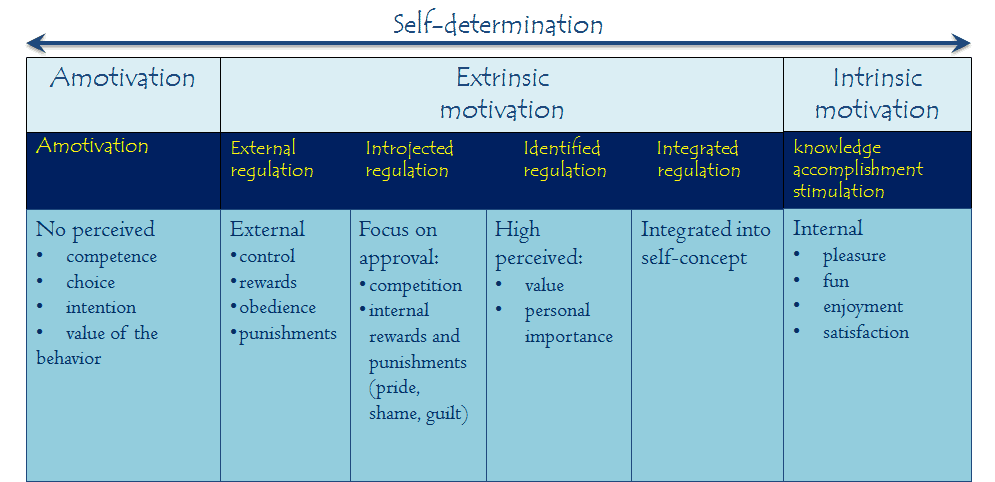Self-Determination Theory: Intrinsic and Extrinsic Motivation
Self-Determination Theory is a theory of motivation that aims to explain individuals’ goal-directed behavior (Deci & Ryan 1985; Ryan & Deci 2000). The theory proposes universal, innate psychological needs:
- Competence is defined by a perceived self-belief in one’s ability to perform well in an activity, e.g. in triathlon;
- Autonomy or freedom of choice. Perceived autonomy is high when individuals feel they are engaging in sport because they choose to do so, not because they feel pressured by other people (parents, coaches) or external factors (expectations).
- Psychological relatedness is defined by a sense of shared experience and meaningful relationships. Therefore, people are motivated by activities which allow them to form and enjoy good relationships.
Thus, people feel motivated by activities which allow them to satisfy those three needs. Those activities are enjoyable and driven by intrinsic motivation. Originally, the theory differentiated between intrinsic and extrinsic motivations were. Later, a continuum with varying degrees of individual autonomy was proposed (Deci & Ryan, 2000). Intrinsic motivation represents the most self-determined or autonomous behavior regulation by inherent interest, enjoyment and satisfaction. There are three types of intrinsic motivation:
- Intrinsic motivation toward knowledge is observed if an activity is performed for the pleasure or satisfaction of learning or understanding something.
- Intrinsic motivation toward accomplishment is defined as engaging in an activity for the pleasure of accomplishing or creating something.
- Intrinsic motivation toward stimulation occurs when an activity is performed to obtain stimulating experiences.
Differently, extrinsic or controlled motivation characterizes those activities that yield specific outcomes in terms of rewards or avoided punishments whereas perceived autonomy is low. Within extrinsic motivation there is a continuum of behavioral regulations reflecting the degree to which the behavior has been integrated into the individual’s sense of self. The continuum includes:
- External regulation, where behavior is controlled by external incentives such as praise, rewards, and punishment avoidance;
- Introjected regulation, when the external contingencies have been internalized and the individual acts to facilitate self-esteem (e.g. exhibit ability) or lessen guilt and avoid demonstration of failure;
- Identified regulation, where the behavior is explicitly recognized and valued by the individual;
- Integrated regulation which is then the most autonomous kind of extrinsic motivation and appears when the behavior is fully integrated into personal values and beliefs.
As the individuals progress along this continuum, their motivation becomes less controlled and more self-determined (Ryan and Deci 2000). At the far end of the self-determination continuum is amotivation representing a lack of any impetus for behavior. Importantly, more autonomous motivation is associated with sustained engagement in the behaviour (Wilson, Rodgers, Blanchard, & Gessell, 2003; Vansteenkiste, Simons, Lens, Sheldon, & Deci, 2004; Li, Lee, & Solmon, 2008).
References:
Deci, E.L. & Ryan, R.M. (1985). Intrinsic motivation and self-determination in human behavior. New York: Plenum Press.
Deci, E. L., & Ryan, R. M. (2000). The ‘what’ and ‘why’ of goal pursuits: Human needs and the self-determination of behavior. Psychological Inquiry, 11, 227-268
Li, W., Lee, A. M., & Solmon, M. (2008). Effects of dispositional ability conceptions, manipulated learning environments, and intrinsic motivation on persistence and performance: an interaction approach. Research Quarterly For Exercise and Sport, 79, 51-61.
Ryan, R.M. & Deci, E.L. (2000). Self-determination theory and the facilitation of intrinsic motivation, social development, and well-being. American Psychologist, 55, 68-78.
Vansteenkiste, M., Simons, J., Lens, W., Sheldon, K. M., & Deci, E. L. (2004). Motivating Learning, Performance, and Persistence: The Synergistic Effects of Intrinsic Goal Contents and Autonomy-Supportive Contexts. Journal of Personality and Social Psychology, 87, 246-260.
Wilson, P. M., Rodgers, W. M., Blanchard, C. M., & Gessell, J. (2003). The relationship between psychological needs, self-determined motivation, exercise attitudes, and physical fitness. Journal of Applied Social Psychology, 33, 2373-2392.
